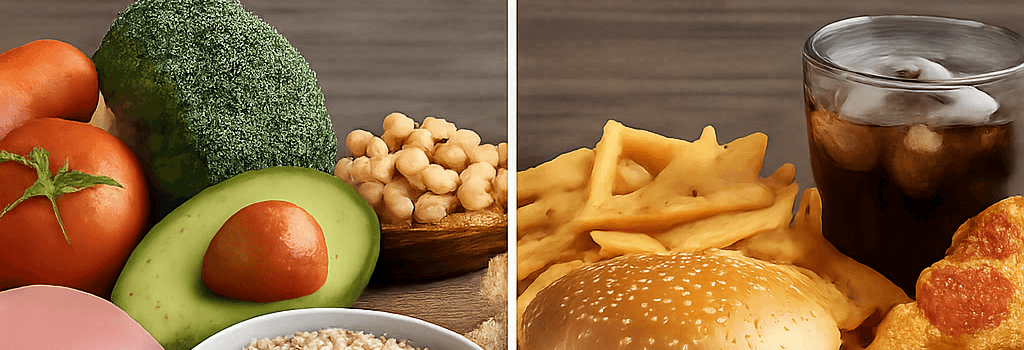Minimally Processed Diet Doubles Weight Loss Over Ultra-Processed Foods

A recent randomized controlled crossover trial conducted by the UCL Centre for Obesity Research demonstrates that individuals consuming a strictly minimally processed (MPF) diet lost twice as much body weight compared to when they consumed an ultraprocessed food (UPF) diet, despite both diets being nutritionally matched for macronutrient content and energy. Published in Nature Medicine in August 2025, this study provides high-resolution insights into how food processing influences energy intake, satiety, and metabolic health.
Study Design and Methodology
The trial employed a rigorous crossover design: 50 adults (mean age 43, BMI 28–35 kg/m2) with overweight or obesity were randomized to receive either the UPF diet or the MPF diet for eight weeks, followed by a four-week washout period, then switched to the alternate diet for another eight weeks. Key methodological details include:
- Randomization and Blinding: Participants were block-randomized and allocation was concealed until baseline assessments. While full blinding was not feasible due to the visible differences in food, outcome assessors remained blinded to group assignment.
- Isocaloric Matching: Both diets were formulated to deliver identical total daily energy (±5%), macronutrient ratios (carbohydrates 50%, fats 30%, proteins 20%), and dietary fiber (25–30g/day), in accordance with the UK Eatwell Guide (EWG).
- Body Composition Analysis: Dual-energy X-ray absorptiometry (DXA) scans quantified total and regional fat mass, lean mass, and bone mineral density at baseline and after each diet period.
- Biochemical and Hormonal Profiling: Fasting blood panels measured triglycerides, LDL and HDL cholesterol, insulin, ghrelin, and leptin. Metabolomic analysis using mass spectrometry provided secondary endpoints on lipidomics and inflammatory markers.
- Adherence Monitoring: Digital food diaries, time-stamped photographs, and weekly 24-hour recalls via a mobile app ensured compliance, supplemented by random urinary sodium and sugar excretion tests.
Dietary Interventions: Ultraprocessed vs Minimally Processed Foods
Ultraprocessed Food (UPF) Diet
The UPF diet included commercially packaged items characterized by industrial formulations and additives:
- Multigrain breakfast cereals with added sugars and emulsifiers
- Pre-packaged granola bars containing vegetable oils and preservatives
- Flavored yogurt cups with stabilizers
- Instant noodles and ready-made frozen lasagna
- Preassembled deli-style chicken sandwiches
Minimally Processed Food (MPF) Diet
The MPF diet comprised freshly prepared meals with minimal industrial processing:
- Overnight oats mixed with raw berries and nuts
- Plain dairy yogurt topped with toasted whole oats and fresh fruit
- Handcrafted fruit-and-nut bars (no added oils or emulsifiers)
- Homemade chicken salad with dressing from scratch
- Freshly stir-fried vegetables with lean protein and handmade spaghetti Bolognese
Key Findings and Outcomes
- Weight Loss Difference: Participants lost ~2.0% of baseline body weight on the MPF diet versus ~1.0% on the UPF diet over eight weeks. When extrapolated to one year, modeled projections estimate 9–13% vs 4–5% weight loss, respectively.
- Fat Mass and Lean Mass: DXA scans revealed greater reduction in total fat mass (–1.5 kg vs –0.8 kg) and preservation of lean mass on the MPF diet.
- Biomarkers of Cardiometabolic Health: The MPF diet led to significantly lower fasting triglycerides and reduced ghrelin concentrations, indicating improved satiety. Conversely, the UPF diet showed modestly lower LDL cholesterol, potentially due to phytosterol content in certain packaged items.
- Subjective Appetite and Food Cravings: Visual analog scale (VAS) scores and the Three-Factor Eating Questionnaire (TFEQ) indicated reduced hunger and cravings on the MPF diet, aligning with longer oral processing time and higher satiety ratings.
Mechanistic Insights: Energy Density and Chewing Time
The authors hypothesize that the higher energy density (kcal/g) and hyperpalatability of ultraprocessed foods accelerate consumption rate, resulting in higher spontaneous caloric intake. In contrast, the MPF diet required more chewing and exhibited longer oro-sensory exposure, which may engage satiety hormones (e.g., peptide YY, GLP-1) more effectively. These mechanistic pathways are supported by recent studies employing ambulatory bite counters and high-resolution videography to quantify chewing cycles, finding a 35% longer mean chewing time for minimally processed meals.
Integration of Digital Health Tools in Dietary Trials
Advancements in mobile health (mHealth) platforms enable real-time adherence monitoring and data collection at scale. In this trial, the bespoke smartphone app integrated:
- Time-stamped meal photography with automated portion size estimation using computer vision algorithms.
- Continuous glucose monitoring (CGM) devices to correlate postprandial glycemic responses with food processing levels.
- Wearable accelerometers to adjust for confounding variables such as physical activity.
Expert opinion: Dr. Maria Sanchez, a digital nutrition researcher at Imperial College London, notes, “Incorporating AI-driven image analysis and CGM data can refine dietary intake accuracy and support personalized nutritional feedback.”
Machine Learning for Personalized Nutrition
Emerging machine learning models can predict individual weight loss responses based on baseline microbiome profiles, genomic data, and dietary patterns. By integrating multi-omic datasets from the UCL trial, future research aims to develop predictive algorithms that recommend optimal food processing levels for each person. This precision nutrition approach aligns with initiatives by the European Commission’s Joint Programming Initiative on Precision Nutrition.
Limitations and Future Research Directions
Despite robust design, the trial’s limitations include its relatively short duration, small sample size, and predominance of female participants. Longer-term studies with larger, more diverse cohorts are needed to evaluate sustained cardiometabolic outcomes and to clarify the long-term impacts on LDL cholesterol and gut microbiome shifts. The research team has planned a follow-up trial utilizing metabolomic profiling and isotopic tracer techniques to map substrate oxidation rates under different dietary processing conditions.
“While adhering to macronutrient guidelines is crucial, our findings underscore the added benefit of choosing less-processed, whole foods to enhance weight loss, satiety, and overall metabolic health,” said Professor Rachel Batterham, senior author.
Public Health and Policy Implications
This trial bolsters calls by the World Health Organization to limit ultraprocessed food consumption and informs national dietary guidelines, such as the UK Eatwell Guide and the US Dietary Guidelines for Americans. Policymakers may consider front-of-package processing labels and taxation of UPFs to incentivize whole-food consumption.